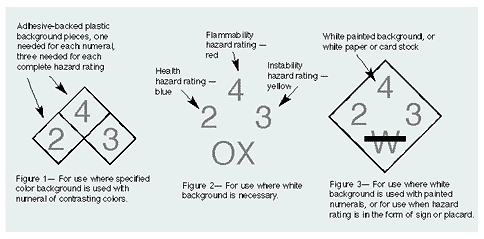

NFPA 704: Hazardous Materials Identification System
By Grainger Editorial Staff
Quick Tips #178
The NFPA 704: Hazardous Materials Identification System standard protects the health and safety of individuals who respond to fire and chemical emergencies in facilities or storage locations where the hazards of materials are not readily apparent or known. The standard addresses the health, flammability, instability and related hazards that are presented by short-term, acute exposure to a material during a fire, spill or other emergency-related condition.
NFPA 704: Hazardous Materials Identification System is a simple, recognizable and easily understood marking system that provides a general idea of the severity of the hazards of a material. The standard applies to industrial, commercial and institutional facilities that manufacture, process, use or store hazardous materials. The NFPA 704: Hazardous Materials Identification System standard does not apply to transportation requirements, general public use or occupational exposure.
Hazard Symbols
A system of categories, colors and numbers was created to provide basic hazard information. It enables firefighters and other emergency personnel to easily decide whether or not to evacuate an area or proceed with emergency control operations. The three principal categories of identification are health, flammability and instability. A numerical range of 0 to 4 indicates the severity of the hazard, where 4 indicates the most severe and 0 indicates a minimal hazard.
The information is presented in a color and spatial arrangement of the numerical ratings: health hazard, blue, at the 9 o'clock position; flammability rating, red, at the 12 o'clock position; and the instability rating, yellow, at the 3 o'clock position. (Figure 2) Alternately, the square-on-point field is permitted to be any contrasting color. If this is the case, then the numbers themselves must be colored coded. (Figures 1 and 3)
The fourth space at the 6 o'clock position is reserved for indicating unusual reactivity with water. It is designated by the letter W with a line through the center. No special color is associated with this symbol. If the space isnt needed to indicate reactivity with water, only then can the space be used to indicate other unusual hazards. For example, materials that possess oxidizing properties are identified by the letters OX. (Figures 2 and 3)

Assignment of Ratings
Only people who are technically competent and experienced in interpreting the hazard criteria contained in the NFPA 704: Hazardous Materials Identification System standard can determine the correct numerical ratings for a specific material. The system is based on relative, rather than absolute values. Therefore, varying conditions of storage and use can result in different ratings being assigned to the same material by different people. In situations where a variety of materials is present at one location (e.g., warehouses, storage rooms or laboratories), considerable judgment is required to properly assign ratings to that area. Assignment of ratings is based on factors that encompass both knowledge of the inherent hazards of the material as well as its anticipated behavior under conditions of exposure to fire or fire-control procedures. For additional information on hazard rating assignment, see NFPA 704 (appendix B, C, and D), NFPA 49: Hazardous Chemicals Data and NFPA 325: Guide to Fire-Hazard Properties of Flammable Liquids, Gases and Volatile Solids.
Commonly Asked Questions
Q: Is The NFPA 704 a requirement? Who enforces this requirement?
A: The NFPA 704: Hazardous Materials Identification System standard is a voluntary standard; each local jurisdiction determines whether or not it will be maintained as a requirement.
Q: How is a rating determined for a facility containing many different hazard materials?
A: Hazard evaluations and numerical ratings must be performed by persons who are technically competent and experienced in the interpretation of hazard criteria. Assignment of ratings requires a vast knowledge of the inherent hazards of materials and the anticipated changes in behavior when reactive materials are exposed to fire or fire-control procedures.
Sources
Fire Protection Guide to Hazardous Materials. National Fire Protection Association. 12th edition, 1997.
www.nfpa.org
![]()
The information contained in this article is intended for general information purposes only and is based on information available as of the initial date of publication. No representation is made that the information or references are complete or remain current. This article is not a substitute for review of current applicable government regulations, industry standards, or other standards specific to your business and/or activities and should not be construed as legal advice or opinion. Readers with specific questions should refer to the applicable standards or consult with an attorney.






